A weekend getaway in the unexplored Sindhudurg, experiencing rustic luxury in Coco Shambhala
YS Life recently visited Coco Shambhala in Sindhudurg’s Bhogwe village to experience a slice of the coastal Konkan life.
On a cloudy Saturday morning, I set out on a two-hour car ride from Goa to Maharashtra. The mesmerising journey through the highways—lined with lush green hills of the Western Ghats—made me forget about my car sickness.
Taking a sharp left after 90 kms, I spent the next 35 minutes driving through narrow roads between forests and sparsely inhabited villages. I crossed local markets, a government school, and an iconic statue of Shivaji—a sign that I had arrived in Maharashtra.
The last leg of my journey, through the narrow coastal Konkan plain in western Maharashtra, led me to Sindhudurg.
Located on the coast of the Arabian Sea, Sindhudurg is one of those rare gems deserted owing to urbanisation. Popular for the famous Sindhudurg Fort built by Shivaji, the Malvan district is now inhabited by the elderly locals who prefer farming over modern amenities of city life, home-sick youngsters who travel for hours to nearby industrial town Kudal or farther to Goa, and the occasional tourists searching for an escape from their fast-paced life.
I belonged to the third category, who wanted to get a glimpse of the rustic, yet well-lived village life. I made my way to Coco Shambhala—an eco-conscious luxury retreat located at the foot of the unexplored Bhogwe Beach.
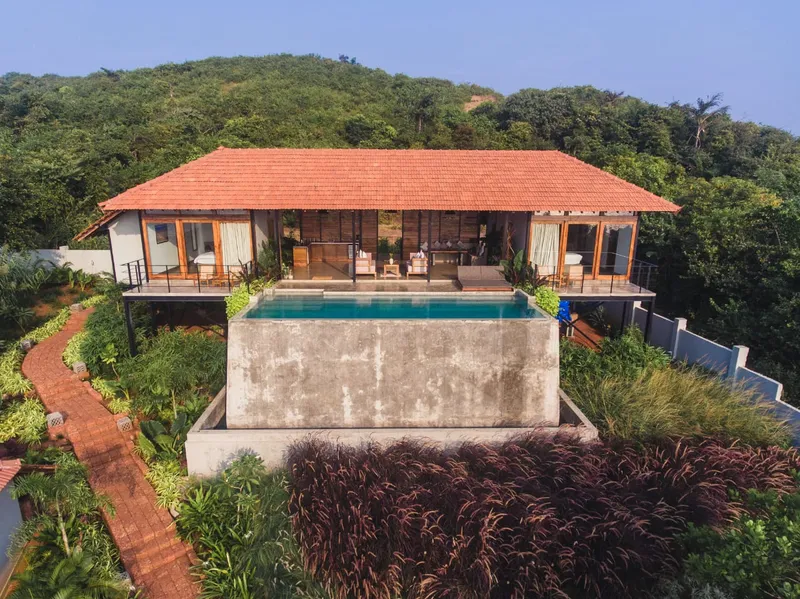
Aerial view of one of the four luxury villas of Coco Shambhala, Sindhudurg | Image source: Team Coco Shambhala
Experience a slice of luxury at this 300-year-old Portuguese mansion turned boutique hotel in Goa
An eco-conscious retreat
On arrival, manager Revan Gawade showed me the way—a vintage, sea-green wooden door led to laterite steps, caressing past palms, cashew trees, and plumerias, leading uphill to four villas—each seated on different levels and offering a breathtaking view of the Arabian Sea.
European backpacker and architect Giles Knapton’s passion for tropical architecture and garden design led him to form the hospitality company Driftwood Holidays in India. “My ambition was to create a responsible hospitality model through design and core business values,” Knapton tells YS Life.
After his first property in Goa, in an attempt to further expand his business, Knapton started trekking along the Konkan coast, searching for a suitable location for a second Coco Shambhala. After years of trekking, he found a stunning location overlooking Bhogwe Beach.
He built these four villas—each 140 sq mts, including a private infinity pool overlooking the beach. “We spent a great deal of time planning to ensure we did not use any machinery on site, with no JCB allowed on the land,” Knapton says.
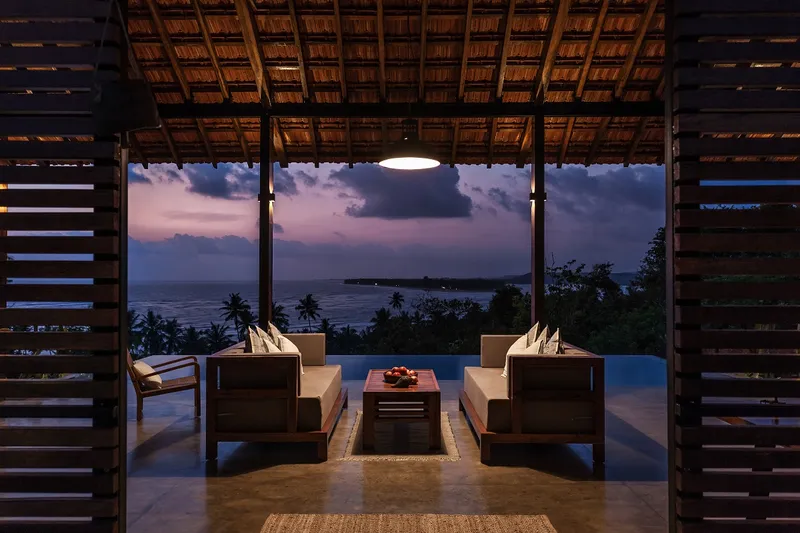
The living room overlooks the infinity pool and the Arabian Sea beyond it | Image source: Team Coco Shambhala
The villas—Arka, Amaresha, Inaya, and Varenya—sit on steel pillars, ensuring minimum impact on the ground and without disturbing the natural contours of the land. “The principle behind the design was to construct without any structural welds, instead using nuts and bolt joints, so that in the years to come, we could dismantle the villas and leave the site without a scar on the land,” he explains.
Barefoot luxury
The word ‘Shambhala’ refers to the mythical kingdom in Central Asia, where harmony, good health, and well-being were given utmost importance. And ‘coco’ comes from Goa’s Coco Beach, where Knapton’s first property is located.
True to its name, Coco Shambhala promotes relaxation and a stress-free experience away from city life. While the location and its surroundings caught my attention, the villas’ openness got me excited.

The absence of a door ensures ample cross-ventilation of the sea breeze in the villas | Image source: Team Coco Shambhala
Inspired by the local way of living, Knapton built these villas in an open-air fashion. Each villa opens to a vast living room overlooking an infinity pool and the beach. They are no doors; a mere jute string wrapped around the wooden railings of the entrance replaces the plastic ‘Do Not Disturb’ signs of hotels. The absence of a door also ensures ample cross-ventilation of the sea breeze.
Each of these two-bedroom villas features Mangalorean clay tiles roofs and coconut wood furniture—comfortable beds, cupboards, rustic washrooms adorned with modern amenities, television, and sit-out balconies opening to the sea.
Rooms also feature a curation of hand-picked books, upcycled clocks, and pots used as decorative pieces. These villas feature open dining areas and in-house bars stocked with a wine collection.
The colour palette is natural and minimal, “allowing tropical plants and fauna to become the decorative element of the house,” Knapton says. The plants run through the villa, seamlessly linking the outdoors with the indoors.
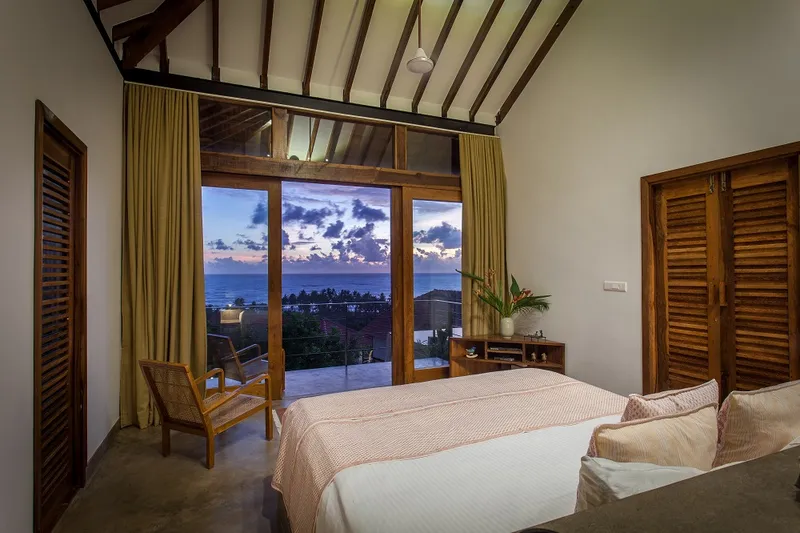
Each bedroom features a sit-out balcony overlooking the sea | Image source: Team Coco Shambhala
As I sat down in the living room, taking in the vast expanse of the sea before me, Gawade tells me there are dolphins 500 metres under my villa, leopards beyond the boundary wall, cuckoos, koels, robins, and kingfishers lining the pool’s end, and langurs on the trees.
Local treats
Two days before my visit, Suhas Malewadkar, the F&B Manager at Coco Shambhala, called me to understand my dietary preferences and allergies. He shared an elaborate meal plan for my stay at the property.
The reason: the Bhogwe village, housing about 1,000 people, does not offer city-like modern facilities. As a remote destination, it sources ingredients from Kudal or within a 30-km radius of the property and meals are planned in advance.
“We do not function like a walk-in restaurant. Our in-house chefs prepare a menu for our guests, and we source the vegetables, seafood, and meat accordingly,” Malewadkar tells me during my visit. Coco Shambhala grows its microgreens and herbs behind the kitchen and in the property’s garden.
I was curious initially when Malewadkar shared the meal plan. An amalgamation of local Malvani, fusion, and coastal cuisine, everyday ingredients make way for unique recipes.

The lunch spread included local Malvani delicacies | Image source: Debolina Biswas
Think, bottle gourd soup, Malvani chilli chocolate ganache, ravioli made from fenugreek and cottage cheese, ridge gourd salad, curry leaf sungta, paneer zeppole, and modak with sweet coconut sauce. The food at Coco Shambhala exudes the coming together of local and international fares.
“We employed women from the village to teach us authentic local dishes and chefs who could reinterpret international dishes using the local produce and ingredients. We wanted our guests to be authentic and abide by our core principles to provide a responsible tourism model,” Knapton explains.
The property does not feature any reception, lobby, or restaurant, and yet, the staff are just as professional and the service—top-notch. The dining table is laid for each elaborate meal, featuring clay plates and coconut shell ladles, and the staff provides a detailed explanation of each dish that makes it to the table.
On the last night of my stay, the staff arranged for a special dinner—one they do for each of their guests. Under one of the cashew trees, the team laid a table and set it up with candles, lanterns, leaves, and flowers sourced from the garden. While the clouds were a hindrance to my star-gazing experience, the four-course meal formed a core memory.
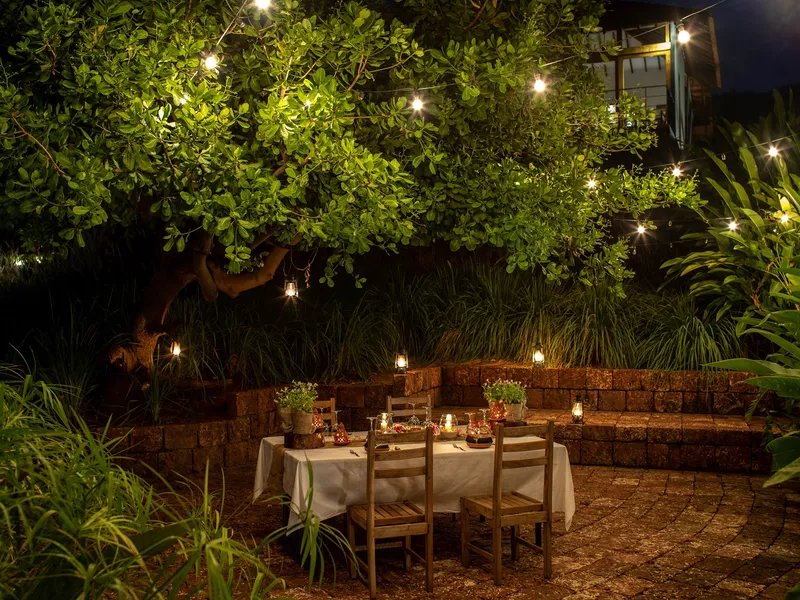
Special dinner set-up under the cashew tree | Image source: Team Coco Shambhala
Rustic way of life
Staying at Coco Shambhala comes with an unsaid rule book—you must wake up at the crack of dawn and hit the bed with sunset.
Despite being a quaint district, Sindhudurg offers much to do, and Malewadkar suggests that every guest must spend at least three nights to make the most of it.
The property helps curate experiences for their guests based on their preferences and seasons. Outdoor activities include water sports like parasailing, jet skiing, and surfing at the nearby Tarkali beach, hiking, night safari, scuba diving, taking boat rides, walks across the villages, dolphin spotting, and barbecues on the beach.
Indoor activities include art and craft workshops, puppet shows, cooking classes, and pottery workshops, among others.
However, a time crunch and the onset of the monsoon limited my options. On the first day, I went for a boat ride across the Karli River. Geared with umbrellas, a pair of binoculars, and fresh coconut water, Malewadkar accompanied me on a local fishing boat, which converts into a ferry for the villagers.
The 20-minute ride around a small island involved spotting eagles, kingfishers, and peacocks. As I rowed around the islands, small fishes flipping in and out of the water made to my trip’s highlight in an otherwise calm evening.
I also managed to make it to the 800-year-old Laxmi Narayan Temple in Walaval village. The temple compound made with Hemandpanthi-style architecture houses a 14th-century reservoir.
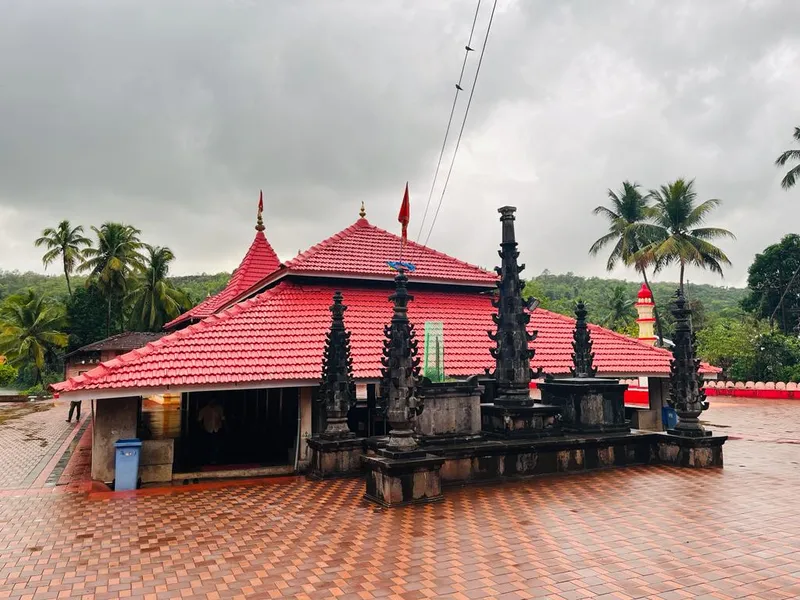
The Laxmi-Narayan temple in Walaval village of Sindhudurg | Image source: Debolina Biswas
On day two, I accompanied Babu—a sexagenarian villager and staff at Coco Shambhala—for a guided hike across the Bhogwe village through forests lined with mango and kokum trees across the Neuti and Nivati beaches and up to the Nivati Fort.
The 10 km hike seemed daunting at first, and I almost prayed to the Rain Gods to cancel my plans, but Babu’s enthusiasm, his stories as we crossed different landscapes, and the magnificent view of the sea from the top of the fort made my early Sunday morning worth it.
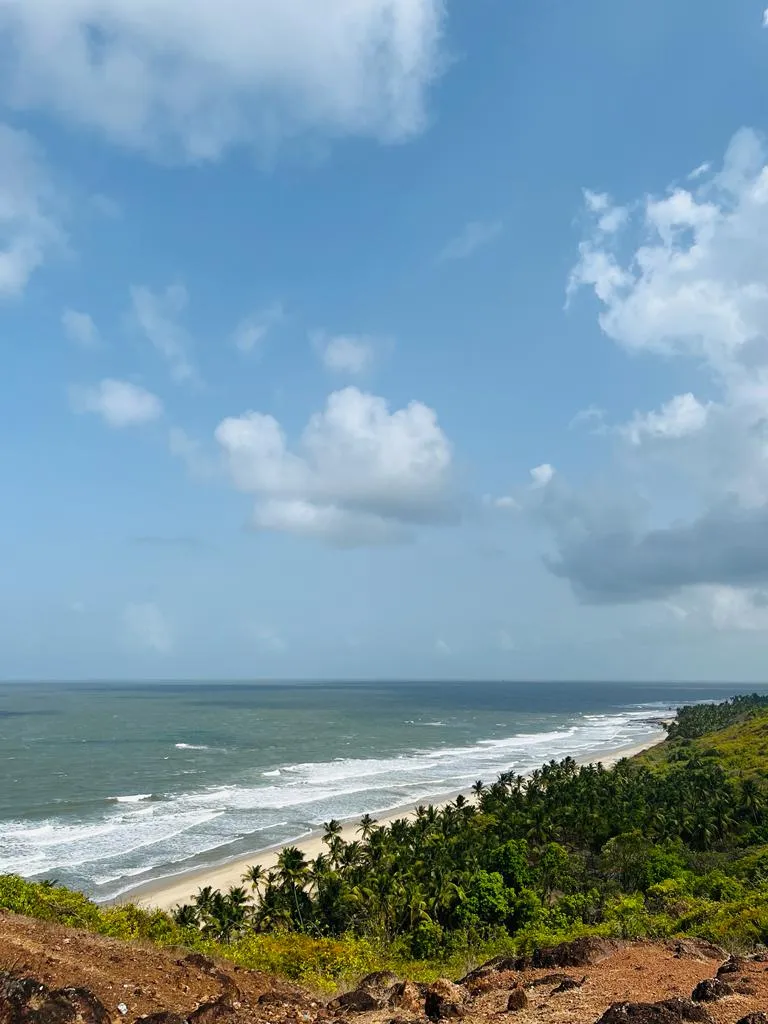
The view from the top of the Nivati Fort in Sindhudurg | Image source: Debolina Biswas
I came back to a vast spread for breakfast and enjoyed a quick dip in my private pool before heading to the in-house spa to cater to my sore muscles from the hike.
In the evening, in-house chef Bahadur helped me learn three new dishes—ridge gourd and gram salad, smoked and grilled fish fillet in clam, lemongrass, and coconut broth, and curry leaf poached prawns—which I feasted on later.
Long story short, Coco Shambhala gave me a taste of the Konkan village life during my brief stay at the property. And, while I did not spot any leopards, I was greeted by a couple of langurs during lunch.
While every season has its peaks, YS Life suggests you visit Coco Shambhala during monsoons to make the most of the lush green surroundings.
Rates (during off-season): Rs 55,000 per night (including breakfast and airport transfers)
Rs 70,000 per night (includes all meals and airport transfers)
Edited by Suman Singh







